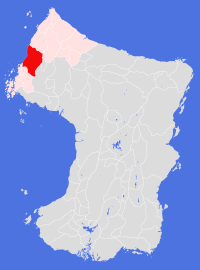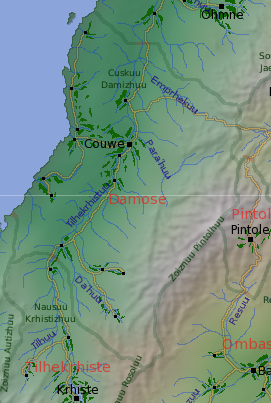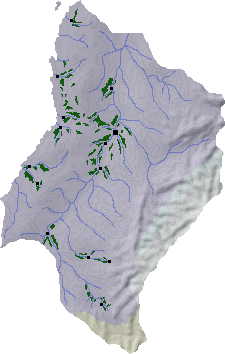Damose

Societal ties: Bartak
Current population: 1
Main language(s): Dam Bathtel
Area: 232,000km²
Natural and political borders
The Land stretches along the north western coast between the latitudes of 39.7° and 44.2°N, encompassing the coastal hills and the central part of the Tilhekrhistuu valley beyond them, then eastwards to the Zoiznuu Pintolhuu watershed.
There are two political borders, both centred on the Tilhekrhiste river. In the north, Damose has claim to the river and tributaries south of latitude 40.5°N, while in the south it has a similar claim north of latitude 38.6°N.
History
The area that eventually became the Land of Damose was initially developed by the Tells Authority. Alongside Defe, the Smikuu Damizhuu was cultivated as part of the first stage of the planned evacuation of whole communities to Ewlah. Cultivation by authority pioneers, with the assistance of more northern settlements, began in the coastal settlements in the early gt530s, and the new settlements accepted their first migrants in gt537.
From the beginning, the settlements prospered, and work continued on their expansion as people continued to arrive - though other Authority-sponsored settlements along the northern coast of the continent proved to be more popular as they offered a slightly drier climate. By gt640 many of the coastal settlement cultivations had merged, and the largest cultivation - by now known as the Cuskuu Damizhuu Plantation - had stretched inland to the Tilhekrhistuu river.
In gt650 the foundations for a new city - Couwe - were laid out in uncultivated land along the banks of the river Tilhekrhistuu. Legend has it that the ceremony to inaugurate the city attracted the attention of a meteorite! All the settlements contributed to the building of the city, which from the outset was built of stone rather than wood. The purpose of the city was to act as an administrative centre and market, promoting trade and industry between settlements, acting to stabilise and influence markets and to house a centralised legislative and legal system. Within 20 orbits the population of the city was greater than the combined population of the rest of the settlements - a population movement that almost bought about the collapse of the nascent state.
By gt690, the economy and local society had managed to adapt to the new demographics, and a period of new economic activity and expansion began. Much of this activity took place in the central valley north of the city - an area that was also being explored and exploited by people from the Land of Omne. As competition for resources grew between the two groups, so did their bellicosity towards each other. By gt710 both sides had standing armies and a rapidly developing arms industry.
The inevitable came to pass in gt712 when armed conflict between the two sides escalated into war. The war was an intermittent affair, with no quarter given by either side. Battles were bloody and the numbers of dead and wounded quickly rose. The shock of war had a profound effect on both sides, and sanity finally prevailed just over an orbit later when both sides agreed to a cease-fire.
Negotiations for a more permanent peace took a further three orbits, though a renewal of hostilities was never a serious possibility. In gt716 the southern settlements constituted themselves as the Land of Damose, which immediately signed a peace and reconciliation treaty with the Land of Omne.
The repercussions of the war were far more widespread. All Bartak Society was shocked by the conflict. In gt720 the key Bartak Lands and settlements agreed to establish the Bartekol League, of which the Land of Damose was a founding member.
The peace dividend that followed the war allowed the Land to recover quite quickly. Now the city turned its sights southwards, establishing a number of new settlements in the Tilhekrhiste and Da'huu valleys during the second half of the eighth century, and exploring deep into the Nausuu Krhistizhuu.
In gt820, explorers discovered extensive silver and copper deposits in the Frhoshmuu Bracizhuu, in the southernmost part of the valley. The discovery triggered a 'gold rush' mentality - it is estimated that up to 10 per cent of the Land's population may have moved south in search of their fortune over the course of the next five orbits. The loss of people hit the Damose economy hard, and an attempt by the Land's authorities to control and profit from the discovery failed miserably. The Bartekol League intervened in gt826, sending a joint task force to bring some semblance of lawfulness to the mining settlements and to alleviate the worst of the human misery there - a task force from which the Damose authorities were excluded.
Between the gt820s and the gt870s, Damose endured a gentle decline in growth and productivity, both economic and social. The total coverage of cultivated land also shrunk. The opening of a new trade route across the mountains to the Land of Aelhpaase in gt875 helped to reverse this trend.

Politics and economy
Today, Damose is a productive and relatively rich Land, with all the trappings of a nation state. The main political focus is a national assembly, elected roughly every 6 orbits. Local politics is handled by the temple outside of the city; Couwe has a more formal council to handle infrastructure and other issues. While power regularly changes between parties, the politics of each party does not tend to differ substantially on key economic and social issues.
The Land maintains a small standing army and navy - principally to combat banditry and piracy. Civil defence and neighbourhood safety is performed by settlement guards and the city police.
The Land has a competitive market economy, with trade conducted in the national currency controlled by a central bank - people are less willing to accept the currencies of other Lands in Damose than happens elsewhere in Bartak Society. Currency export is discouraged. Damose is a manufacturing centre, importing many raw materials and exporting a wide array of heavy and light industrial goods. There is also a strong service sector, and a thriving agricultural market; the Land exports more food than it imports.
The state has invested heavily in transport over the past 50 orbits - all settlements are now connected together by railways, and Couwe has an extensive light rail system. Movement of raw materials and goods is mostly carried out by rail within the Land.
Against the grain of wider Bartak custom, private ownership of land and property is tolerated, though most land and property is remains in communal ownership.
Culture and other issues of interest
Damose society has a tendency towards patriarchism, and the gender differences are more marked here than elsewhere - men are more likely to work in agriculture, mining and heavy manufacturing; women tend to work more in light manufacturing and the service industries, and are often more active in the temple. There is also more of a tendency for the eldest child to inherit from the parents, though only in richer families.
Couwe is noted for its cultural and artistic activities - the state regularly sponsors artworks and performances, and art groups regularly tour through the settlements. Comedy theatre is particularly popular, as is dance and song performances. The technological recovery has helped develop a thriving music industry.
Organised sport, on the other hand, is less popular, with individual pursuits (especially sharpshooting contests) preferred over team sports.
Key natural features
Damose can be divided into a series of vertical stripes. The westernmost stripe covers the coastal lands - a place of undulating hills and short rivers. Beyond these hills is the Cuskuu Damizhuu, through which Tilhekrhistuu river runs northwards. The easternmost portion of the Land consists of the foothills and mountains of the Zoiznuu Pintolhuu; here can be found longer tributaries of the Tilhekrhistuu, the most important of which (north to south) are the Emprhekuu, Para'huu and Da'huu rivers. The mountain chain is high, with the highest peaks being Mt. Fesein (5,060m) and Mt. Pinte (5,470m) - both of which are dormant volcanoes.

Habitats
Almost all of the Land falls within the West Coastal habitat, with thin strips of Northern Scrubland and Northern Mountain habitats along the eastern border.
Plantations and settlements
Damose has been heavily - and relatively easily - cultivated. When cultivation first started, the Tells authority undertook the development of a number of smaller cultivations along the coast rather than deploying their efforts on a single, larger plantation. Over time, some of these settlement cultivations have merged, and the settlers followed a similar pattern of development when moving east into the Cuskuu Damizhuu and beyond.
Today, the Cuskuu Damizhuu Plantation (as it has become known) stretches some 200km along the coast, with a 30km cultivated corridor which stretches 110km east to the river valley, where it continues a further 150km southwards. Within it are found the city of Couwe and five other settlements. Three further settlements can be found along the coast, and two along the valley. The three newest settlements are all in the Da'huu river valley in the far south; these are the only settlements so far established east of the Tilhekrhistuu.
Key towns and cities
Rural population: 0 (0.0% of total)